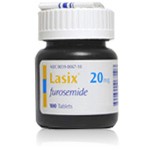Living with Swelling from Heart Failure


Congestive heart failure (CHF) is a chronic and progressive condition in which the heart struggles to pump blood efficiently to meet the body’s needs. One of the most visible and distressing signs of this disease is swelling, or edema, often affecting the ankles, legs, abdomen, and sometimes even the lungs. This swelling is not a superficial problem but a symptom that reflects deeper imbalances within the circulatory system and the body’s ability to regulate fluid. To understand swelling in CHF, it is important to explore why it occurs, how it corresponds to the stages of the disease, and what treatment strategies — including the role of medications like Lasix — can do to control it.
Why Swelling Occurs in Congestive Heart Failure
At the core of CHF lies a weakened or stiffened heart muscle that cannot move blood effectively. When the heart’s pumping capacity declines, blood begins to back up in the veins. This backup raises venous pressure, pushing fluid out of the blood vessels and into surrounding tissues. Gravity causes this fluid to pool in the lower parts of the body, which is why swelling is often first noticed in the feet, ankles, and legs. Over time, the excess fluid may accumulate in the abdomen (ascites) or even infiltrate the lungs (pulmonary edema), making breathing difficult.
The kidneys play a significant role in worsening the swelling. Normally, kidneys regulate sodium and water balance with precision. In CHF, however, the reduced cardiac output is interpreted by the kidneys as a sign of dehydration or low blood volume. To compensate, they retain more sodium and water. This misguided response leads to a vicious cycle: the more fluid the kidneys conserve, the more volume builds up in the bloodstream, and the more pressure drives fluid into the tissues. Hormonal systems, such as the renin-angiotensin-aldosterone system (RAAS), are also activated, further amplifying fluid retention. Thus, swelling in CHF is not only a visible problem but a marker of complex physiological miscommunication between the heart, kidneys, and vascular system.
The Relationship Between Swelling and Stages of Heart Failure
Swelling does not usually appear in the earliest phases of CHF. In the beginning, patients may notice subtle symptoms such as shortness of breath when exercising or an unusual level of fatigue. The body at this stage compensates by increasing the heart rate and dilating the blood vessels, keeping circulation relatively normal. As the condition advances, these compensatory mechanisms lose effectiveness, and signs of congestion — including swelling — emerge.
Swelling becomes most noticeable in the middle to later stages of heart failure. In what cardiologists classify as stage C heart failure, fluid buildup is already common. Patients may observe shoes fitting tighter, rings feeling snug, or unexplained weight gain due to retained fluid. In stage D, the most advanced form of CHF, swelling often becomes pronounced and resistant to treatment, affecting multiple areas of the body. At this point, the swelling signals not only discomfort but also the fact that the body’s natural compensatory systems are exhausted, and intensive therapy is required.
Understanding the Four Stages of Congestive Heart Failure
Medical professionals use a staging system defined by the American College of Cardiology (ACC) and the American Heart Association (AHA) to describe CHF progression. Each stage reflects changes in heart function, symptoms, and clinical findings.
Stage A represents people who do not have structural heart disease or symptoms yet but are at risk due to conditions such as hypertension, diabetes, or coronary artery disease. At this point, there is no swelling because the heart is still functioning normally.
Stage B includes patients who have structural heart changes — such as an enlarged heart muscle or decreased ejection fraction — but still show no outward symptoms. Swelling remains absent, although the groundwork for future congestion is being laid.
Stage C is when symptoms become apparent. This includes fatigue, shortness of breath, and most importantly, swelling in the lower extremities or abdomen. Fluid retention at this stage varies from mild to moderate but is a clear warning sign that the disease has moved beyond silent dysfunction.
Stage D is advanced heart failure. Symptoms are present even at rest, and swelling is often severe. Patients may experience abdominal bloating, significant weight gain, or shortness of breath due to fluid in the lungs. At this point, aggressive treatment and sometimes advanced interventions like mechanical support devices or transplantation are considered.
The progression from stage A to stage D illustrates how swelling is not an early feature of heart failure but a hallmark of its middle and later phases.
Approaches to Reducing Swelling in CHF
Managing swelling in CHF involves both medical treatment and lifestyle adjustments. The most fundamental approach is to reduce the amount of fluid and sodium that accumulates in the body. Patients are often advised to follow a low-sodium diet, because sodium promotes water retention. Limiting processed foods, canned soups, and restaurant meals can make a dramatic difference. Fluid restriction may also be recommended for some patients, particularly those with advanced CHF, to prevent excessive accumulation of water.
Elevation of the legs is a simple but effective technique to relieve ankle and leg swelling, as it encourages fluid to return to the central circulation where it can be processed by the kidneys. Compression stockings are sometimes recommended, though not universally, as they can help counteract gravity and prevent pooling of fluid in the legs.
Weight monitoring is a critical self-care measure. Because swelling may develop gradually, patients are taught to weigh themselves daily at the same time of day. A sudden increase of two to three pounds over one or two days often indicates fluid buildup even before visible swelling appears. This allows patients and doctors to intervene early.
Exercise, when approved by a physician, can also aid in reducing swelling. Light to moderate physical activity helps improve circulation and venous return, as well as overall cardiovascular fitness. The combination of diet, activity, and vigilant self-monitoring provides a foundation for controlling edema in CHF.
The Central Role of Medications
While lifestyle measures are important, medication is the cornerstone of swelling management in CHF. Several classes of drugs are used to reduce fluid retention and improve heart function. Among these, diuretics play the most immediate role. They encourage the kidneys to excrete excess sodium and water, thereby reducing blood volume and venous pressure.
Other medications such as ACE inhibitors, ARBs, beta-blockers, and aldosterone antagonists do not directly reduce swelling but improve heart efficiency and limit the activation of fluid-retaining hormones. By supporting the heart’s function and lowering the workload, these drugs indirectly help in controlling edema over the long term.
Lasix: A Key Tool in Controlling Swelling
One of the most widely used diuretics in CHF management is Lasix, the brand name for furosemide. It belongs to the loop diuretic class, which acts on the loop of Henle in the kidneys to block sodium and chloride reabsorption. This powerful action causes a significant increase in urine output, effectively mobilizing large amounts of excess fluid from the body. Within hours of taking Lasix, patients often notice relief from swelling, improved breathing, and reduced weight due to water loss.
The benefits of Lasix extend beyond symptom control. By reducing fluid overload, it helps lower venous congestion, preventing further leakage of fluid into tissues and relieving pressure on the heart. This reduction in fluid burden can also make other heart medications more effective, as the heart pumps more efficiently when not overwhelmed by volume overload.
However, Lasix is not without its challenges. Because it promotes rapid fluid loss, it can also cause electrolyte imbalances, particularly low potassium and magnesium levels. Dehydration and kidney function decline are other potential risks if the medication is not carefully monitored. For this reason, doctors frequently check blood tests to ensure that electrolyte and kidney function remain stable. Patients may also be advised to take potassium supplements or use potassium-sparing drugs alongside Lasix to maintain balance.
Despite these precautions, Lasix remains a cornerstone therapy for swelling in CHF. Its rapid effect and proven track record make it indispensable in both acute and chronic management. In severe cases of fluid overload, intravenous Lasix may be administered in hospitals to quickly reverse dangerous levels of congestion.
Looking Beyond Swelling: Comprehensive CHF Care
Although swelling is one of the most visible aspects of CHF, it is only one part of a complex condition. Treating the swelling alone does not cure heart failure but provides relief and helps prevent complications such as skin breakdown, infections, and impaired mobility. The broader goal of treatment is to preserve heart function, improve quality of life, and extend survival.
This involves a combination of medications, lifestyle adjustments, and sometimes devices such as pacemakers or implantable defibrillators. In advanced cases, surgical options, ventricular assist devices, or transplantation may be considered. Swelling serves as a vital signal to patients and doctors alike that the disease is progressing and requires close attention.
Conclusion
Swelling in congestive heart failure is far more than a cosmetic concern — it is a visible reflection of the body’s struggle with fluid overload and cardiac dysfunction. It develops because the failing heart cannot keep up with circulation demands, leading to venous congestion, kidney miscommunication, and hormonal changes that trap sodium and water in the body. Swelling typically appears in the middle and late stages of heart failure, providing a marker of disease severity and progression through the four recognized stages.
Managing swelling involves careful balance: dietary sodium reduction, fluid restriction, exercise, leg elevation, and above all, medications. Among these, Lasix stands out as the most effective and immediate treatment, offering relief while requiring careful monitoring. Ultimately, controlling swelling improves not only comfort but also prognosis, making it one of the most important aspects of comprehensive CHF care.
Drug Description Sources:
U.S. National Library of Medicine, Drugs.com, WebMD, Mayo Clinic, RxList.
Reviewed and Referenced By:
Dr. Clyde W. Yancy, MD, MSc, FACC, FAHA Chief of Cardiology, Northwestern University Feinberg School of Medicine. Former president of the American Heart Association. Widely published on heart failure management, fluid overload, and patient outcomes.
Dr. Maria Carolina Delgado-Lelievre, MD Certified Hypertension Specialist, Director of the Comprehensive Hypertension Center at the University of Miami. Her work emphasizes advanced care models for fluid retention and cardiovascular complications in congestive heart failure.
Dr. Milton Packer, MD Distinguished Scholar in Cardiovascular Science at Baylor University Medical Center. Internationally recognized for clinical trials in heart failure therapies, including diuretics like furosemide (Lasix) and novel drug classes for reducing congestion.
Dr. Suzanne Oparil, MD Professor of Medicine at the University of Alabama–Birmingham. Pioneer in hypertension and cardiovascular disease research, with particular contributions to understanding sodium retention, vascular remodeling, and their links to CHF swelling.
(Updated at Oct 2 / 2025)

